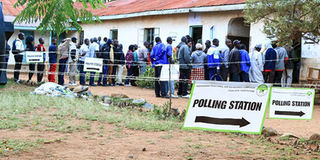Let Kenya’s ethnic rainbow form one nation

Voting in the Migori senatorial by-election takes place at Migori Primary School polling station on October 8, 2018. Kenyan ethnic communities have largely been mobilised by their political elite to vote en masse. PHOTO | FILE | NATION MEDIA GROUP
What you need to know:
- The constitution supports positive ethnicity and right to identity, existence and development.
- We must substitute the principle of organising the country on ethnic cleavages with pro-people ideology.
Why do our leaders identify negative ethnicity as the engine of political backwardness and then repeatedly deploy ethnic politics to win power?
Why do we, as citizens, perennially complain about ethnic manipulation, and yet embrace ethnic chauvinism? Why are our tribes, nations and Kenya a motley of disparate tribes?
Hervé Varenne describes ethnicity as “the identification of a group based on a perceived cultural distinctiveness that makes the group a ‘people’.
This distinctiveness is believed to be expressed in language, music, values, art, styles, literature, family life, religion, ritual, food, naming, public life and material culture.”
According to the 2009 population census, five ethnic groups that is Kikuyu 17.15 per cent, Luhya 13.82 per cent, Kalenjin 12.86 per cent, Luo 10.47 per cent and Kamba 10.07 per cent had 64.4 per cent of the country’s population.
HYBRIDITY
However, the Luhya are, strictly speaking, a collection of 16 sub-tribes (or even tribes) that is Bukusu, Idakho, Isukha, Kabras, Khayo, Kisa, Maragoli, Marachi, Marama, Nyala, Nyole, Samia, Tachoni, Tiriki, Tsotso and Wanga.
The Kalenjin also consist of Kipsigis, Nandi, Keiyo, Marakwet, Sabaot, Pokot, Tugen, Terik and Ogiek.
The above two ethnic groups have historically through their leaders’ political ingenuity endeavoured to construct a supra-ethnic formation. As a result, they are competitive in the political and economic arenas.
Varenne describes the above convergence of ethnic types as “hybridity” – the dissolution of rigid cultural boundaries between groups hitherto perceived as separate, the intermixture of various identities, in effect the dissolution of identities themselves’.
The dissolution – partial or complete – of identities is understandably gradual.
Although heavily coloured by political innuendo, former President Daniel Moi created the pastoralist inclined Kamatusa – a union of Kalenjin, Maasai, Turkana and Samburu.
The original Gema in 1971 was supposed to include the Gikuyu, Embu, Meru and Akamba.
POLITICS
In Kenya’s Coast region, the nine ethnic groups called Mijikenda have failed to replicate the Luhya and Kalenjin type of confederation.
Thus, the Digo, Chonyi, Duruma, Giriama, Jibana, Kauma, Ribe, Rabai and Kambe always advocate a desire for union without more. The visionary dreams of Ronald Ngala and Karisa Maitha have remained daydreams.
The creation of supra ethnic formations can only influence the emergence of a Kenyan nation if “hybridity” is not used to guarantee the politico-economic hegemony of the dominant formation(s).
In what has been described as the “politics of tribe”, Kenyan ethnic communities have largely been mobilised by their political elite to vote en masse.
They are made to believe that a share of national resources can only be accessed through inter-community leadership negotiations.
In 1963, the Kikuyu, Luo and Kamba were in Kanu while the Luhya, Kalenjin and Mijikenda were in Kadu. In 1992 the Kalenjin, the Kamba, majority Luhya and the Mijikenda were in Kanu. The other major communities voted for a splintered opposition.
VOTING PATTERNS
In 2002, the majority Mount Kenya, the Mijikenda, Kamba, Luo, Luhya and others were in Narc. The Rift Valley and the North Eastern predominantly voted for Kanu.
In 2007 the Luhya, Luo, Kalenjin and Mijikenda voted for the Orange Democratic Movement (ODM). The Mount Kenya, North Eastern communities, parts of Eastern and Mijikenda voted for the Party of National Unity (PNU).
In 2013, the Kikuyu and Kalenjin voted against the Luo, Kamba, majority Luhya, and the Mijikenda. And 2017 was more or less a replica of 2013.
Unlike the Kalenjin and Luhya, the Luo and Kamba do not have sub-tribes. Interestingly, both the Luo and Kalenjin have remained politically cohesive since independence.
Why then are Kenyan ethnic groups still held hostage by their ethnic political barons? The exposure and political enlightenment of the rural populations is still low.
IDEOLOGY
They do not demand for ideology-based politics and favourable socio-economic policies.
There is still low urbanisation where different communities could mix to realise they share a common economic fate. Many educational institutions are regional, thereby denying students the opportunity to interact nationally.
Useful as the local radio stations are, they, especially during the electoral season, mobilise the ethnic group to vote as a machine.
The majority of the counties do not exhibit the face of Kenya among their public service employees.
Some communities argue that if the national budgets of 1963/1964 up to 2012/2013 and beyond were analysed, the lopsided and inequitable development of the country would become evident.
Kenyans live together in urban areas, as well as in other parts of the country. They work together in the private sector and in the national public sector. Kenyans too do share common places of worship.
CONSTITUTION
Productive “hybridity” and positive ethnicity should be consciously cultivated.
Indeed, the country’s inter-marriage culture has created another tribe of Kenyans, pushing the country to the doorstep of becoming one tribe and nation.
The Constitution in Article 27 outlaws discrimination on basis of ethnic or social origin and authorises affirmative action for groups exposed to past discrimination.
Article 44 guarantees every person the right to use their language and to participate in their cultural life. The constitution therefore supports positive ethnicity and right to identity, existence and development.
We must substitute the principle of organising the country on ethnic cleavages with pro-people ideology.
This recognises the equality of all communities and their equal access to the country’s resources under a regime of justice, fairness, equity and the rule of integrity and law.
The basis of real national unity, under enhanced devolution, is a system that assures citizenship and equal opportunities to all Kenyans.
Prof Kibwana is the Governor of Makueni County





